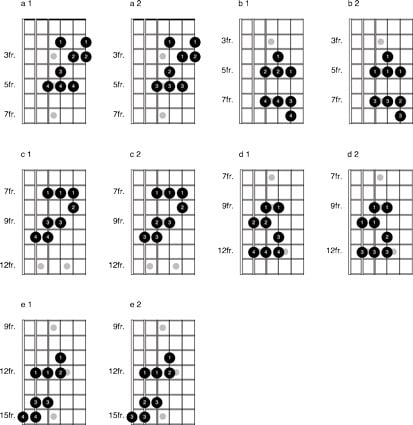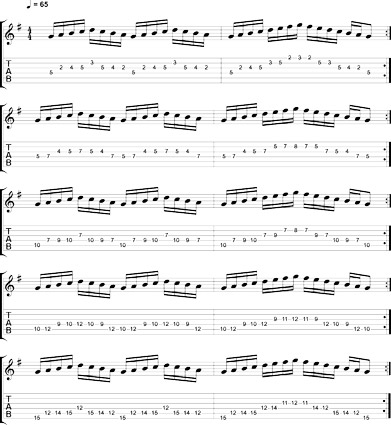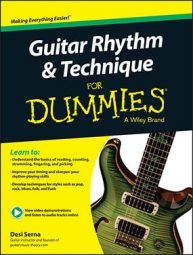You will need to know how to finger major scale patterns, which include more notes and half-steps on the rhythm guitar. You take a look at the different ways to finger patterns and play in positions. The purpose here is to know the process that helps you choose fingerings and arrange parts, so you find what feels right and play to your strengths.
Below, you see two versions of five G-major scale patterns, with the numbers indicating fingerings. There are, of course, more ways to play major scales than this, but these examples are enough to get the point across about fingering options. The first diagram in each set features commonly taught fingerings that utilize the fourth finger, ones that follow a traditional one-finger-per-fret approach where possible and require your thumb to be placed behind the neck.
The second diagram in each set features an optional fingering, one that eliminates the fourth finger and may afford you the opportunity to wrap your thumb. You can watch all these major scales being played on the guitar. Notice how the thumb position changes, and that the first finger is sometimes used twice in a row by sliding it up or down by a half-step.

Many players favor the second examples, but you may feel more comfortable with the more traditional fingerings, or perhaps some other combination not illustrated. Again, these examples are really an exercise in exploring your options — play through them for a while until you settle on fingerings that work well for you.
Try playing through the examples above as fast as you can. You may find that your preferred fingerings don’t work as well when you need to pick up the pace, and a change is in order. Keep this in mind when you work on fast passages.
The examples here feature select patterns in the key of G, but you can apply the same concept in other major scale patterns and keys, always exploring your options and choosing what works well for you.
Next, you work with a melodic idea by repeating it in each of the five pattern positions from the previous figure. As you go, use the fingering examples above, trying both the ones with and without the fourth finger, to see what gives you the best results. You can also put together new fingerings of your own if something else works better for you. This figure is set to just 65 BPM, but you can try faster tempos too, which may affect your fingering choices.

Although the exercises are written all as one piece of music, you should stick with just one line of the music at a time, repeating it until you settle on a fingering and play it fluently. You may find that you play some lines better than others, an indication that the particular positions and patterns are a good fit for you.
As you play major scale parts, including the minor scale and modes that are based in the same patterns, work the areas on the fretboard in which you feel most comfortable.

